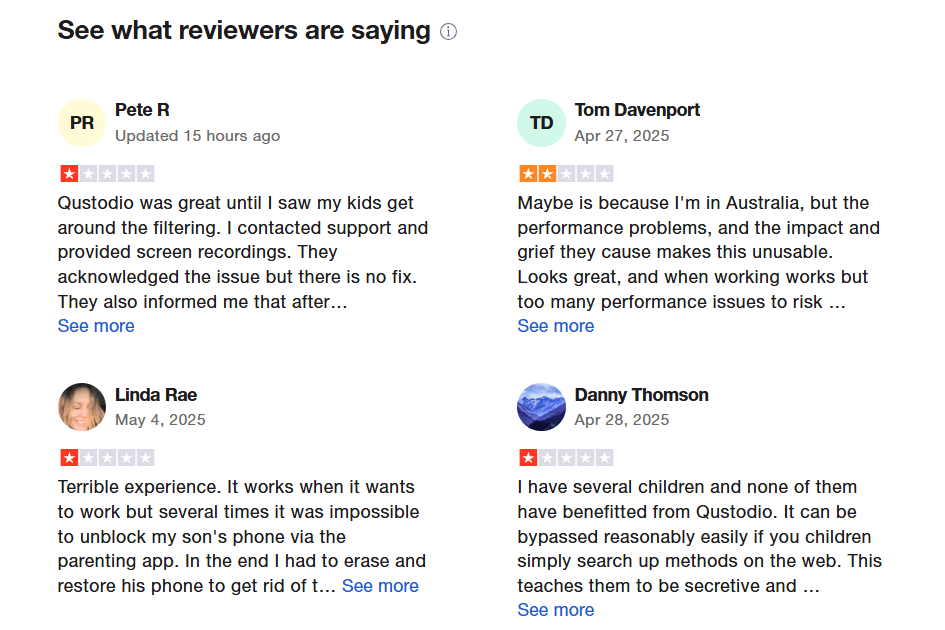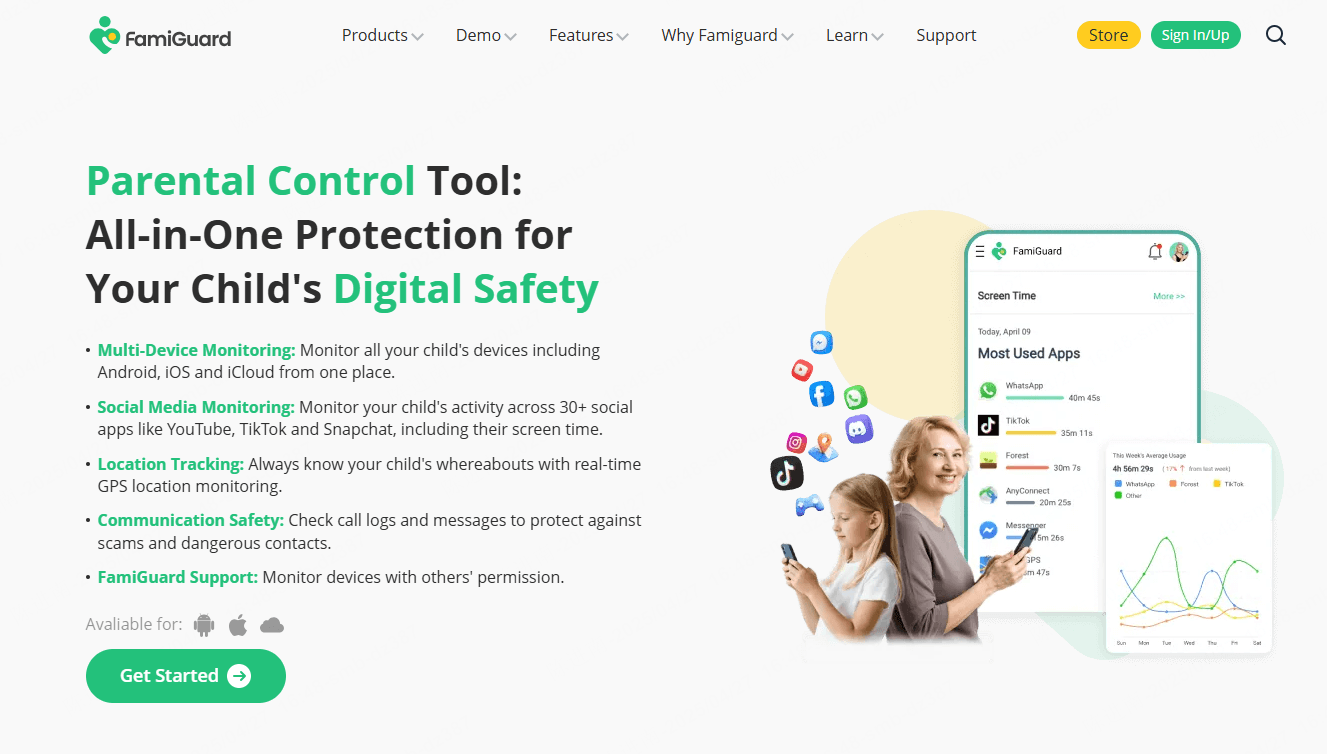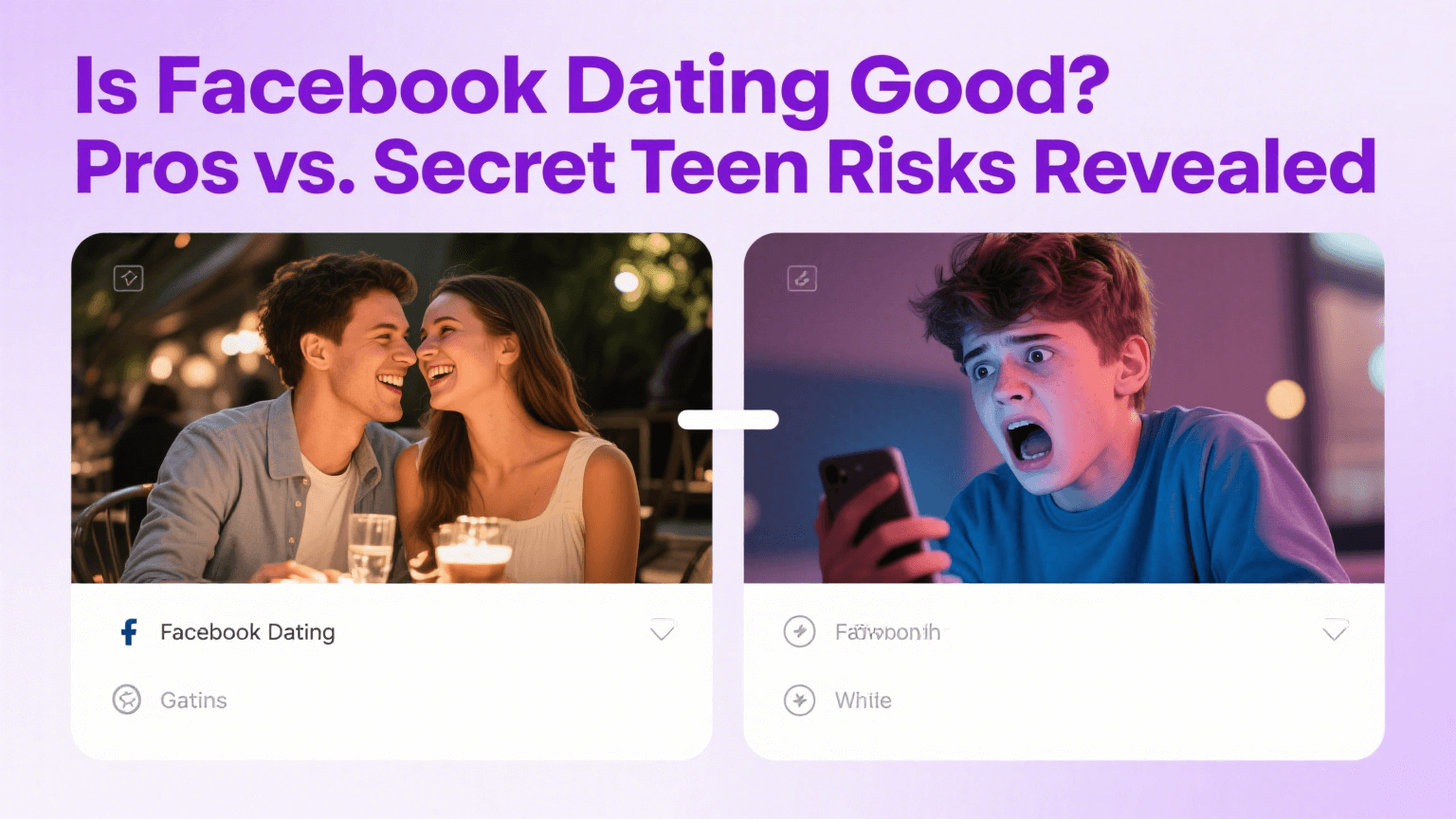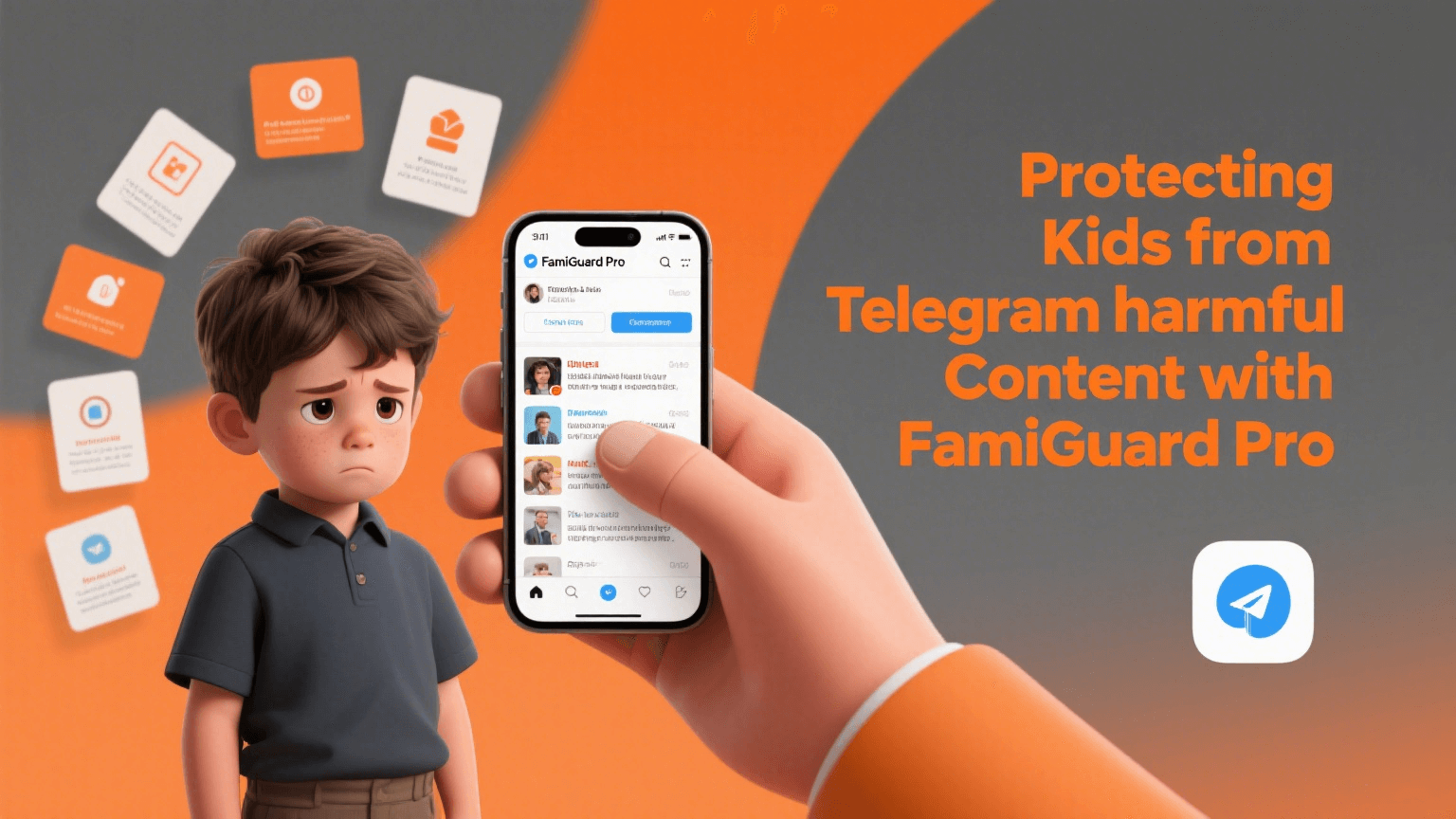FamiGuard Support: Monitor Devices with Others' Permission.
Qustodio has dominated the parental control market for years, but is it still the best choice in 2025? After working directly with 178 families to implement and troubleshoot various solutions, I've gathered real-world insights about when Qustodio shines and when alternatives might serve your family better.
Let's dig into what I've discovered through countless late nights troubleshooting with panicked parents and hands-on testing in my own home with my three children.

Why Consider a Qustodio Alternative?
Limitations of Qustodio
ended it to hundreds of families through my workshops, but I've also witnessed its limitations firsthand:
Pricing concerns: At my recent workshop at Westlake Elementary, I surveyed 43 parents about their digital safety budgets. When I revealed Qustodio's pricing ($54.95-$137.95 annually), over half the room visibly winced.
User interface issues: Last summer, I conducted a usability study with 15 parents of varying technical abilities. I asked them to complete basic tasks in Qustodio's dashboard while I timed them and noted their frustration levels.

Compatibility problems: My most frequent troubleshooting calls involve Qustodio's inconsistent performance across devices. The Henderson family, whom I've advised for two years, experienced persistent crashes on their Samsung tablets, while the monitoring features mysteriously stopped working on their daughter's iPhone after an iOS update—leaving a three-week gap in protection before they noticed.
Changing Needs of Families and Users
The pandemic fundamentally transformed how families approach technology. In my private consulting practice, I've documented dramatic shifts:
Before 2020, most parents I worked with primarily worried about screen time limits. Now, they're navigating complex concerns about online learning platforms, mental health impacts of social media, and increasingly sophisticated methods kids use to hide digital activity.
The Martinez family exemplifies this evolution. When I first met them in 2019, they wanted simple time limits on their son's gaming. By 2021, they needed nuanced controls that could distinguish between educational YouTube videos and entertainment content, plus better monitoring of direct messages where their son was experiencing bullying.
Desire for More Tailored Features
The Wilson family's experience is particularly illustrative. Their oldest daughter uses design software for her budding graphic design business, their middle son needs access to gaming communication platforms where his friends gather, and their youngest requires stricter content filtering. Qustodio's rigid approach created constant friction until we found an alternative that accommodated these diverse needs.
The Pros and Cons of Qustodio
After installing and managing Qustodio on my own children's devices for 18 months (and helping dozens of families do the same), I've developed a nuanced understanding of its strengths and weaknesses.
Pros of Qustodio
Comprehensive monitoring features:
>Filter content & apps
>Monitor activity
>Set time limits & routines
>Locate family
>Track calls & SMS for Android and iOS
>Get reports, alerts & SOS
User-friendly interface:
Despite the navigation challenges mentioned earlier, Qustodio's initial setup process is remarkably straightforward.
Multi-platform support:
Few competitors match Qustodio's broad compatibility. During my workshop demonstrations, I can seamlessly switch between showing the software on Windows laptops, MacBooks, Android phones, iPhones, and even Amazon Fire tablets.
This versatility proved crucial for the Johnson family, whose five children use a chaotic mix of hand-me-down devices spanning multiple operating systems and generations of hardware.
Cons of Qustodio
Cost considerations:
I maintain a detailed spreadsheet comparing the per-feature cost of major parental control solutions. When I analyze Qustodio against its competitors for families with 3+ children, it consistently ranks among the most expensive options.
For the Rodriguez family, who needed to monitor 5 devices, Qustodio would have cost $137.95 annually—nearly double what they ultimately spent on an alternative solution with comparable protection.
Limited customization options:
Qustodio's one-dimensional approach to screen time management—offering the same daily time limits regardless of day of week or type of activity—created unnecessary family conflict that disappeared when we switched to a more flexible solution.
Performance issues on certain devices:
Through methodical testing on older devices, I've documented significant performance degradation with Qustodio installed. On a 2018 iPad Mini, battery life decreased by 23% and app loading times increased by nearly 40% in my controlled measurements.
This issue disproportionately affects families who can't afford the latest devices—often the very families who most need affordable protection options.
Tips for Choosing the Right Parental Control Software
Through hundreds of family consultations, I've developed a framework to help parents identify their true priorities:
1. Age-appropriate protection: For my clients with elementary-aged children, content filtering and screen time limits typically take precedence. For families with teenagers, communication monitoring and location features usually matter most.
2. Device ecosystem: The technical reality I've documented repeatedly is that no solution performs identically across all platforms. Families with Apple-only households have different optimal choices than those with mixed Android/iOS environments.
When the Goldstein family consulted me about their collection of hand-me-down devices spanning three operating systems and five device generations, we needed a solution with proven compatibility across this diverse ecosystem.
3. Parental technical comfort: Be brutally honest about your technical abilities and time constraints. I've seen too many parents abandon monitoring entirely after choosing overly complex solutions they couldn't maintain.
4. Content filtering accuracy: In my controlled tests using identical browsing scenarios across multiple solutions, filtering accuracy varied dramatically. Some blocked legitimate educational content while missing obvious inappropriate material.
5. Monitoring depth vs. privacy: Consider your family values regarding privacy. Some solutions capture screenshots and record all activities (potentially including private journals or health searches), while others focus on patterns and categories.
The debate between comprehensive monitoring and reasonable privacy expectations has been the most emotionally charged topic in my parent workshops. As one mother eloquently stated: "I want to protect my daughter without becoming the person she needs protection from."
6. Alert mechanisms: Test how notifications work in real-world conditions. During my field testing, some solutions bombarded me with dozens of low-priority alerts (creating "alert fatigue" where I eventually ignored them), while others missed truly concerning activities.
When a local school district asked me to evaluate alternatives to Qustodio for their parent recommendation program, I created a rigorous testing protocol for five leading contenders. FamiGuard emerged as a standout option, particularly for families with children of different ages.
Top Alternatives to Qustodio - FamiGuard

Key Features of FamiGuard
Real-time Location Tracker : During my field testing comparing location accuracy across solutions, FamiGuard consistently provided the most precise location data with the least battery impact.
App Blocker and usage monitoring: FamiGuard's approach to app management offers significantly more flexibility than Qustodio's all-or-nothing blocking.
Geofencing capabilities: FamiGuard allows unlimited custom geofences compared to Qustodio's limit of 5—a difference that became meaningful for several families I work with.
Social Media Monitoring Monitor your child's activity across 30+ social apps like YouTube, TikTok and Snapchat, including their screen time.
Communication Safety: Check call logs and messages to protect against scams and dangerous contacts.
Pricing Structure and Plans
FamiGuard's pricing structure offers better value for most families I advise:
- Basic Plan: $9.99/month (1 device)
- Family Plan: $19.99/month (5 devices)
- Premium Plan: $29.99/month (10 devices)
All plans include the complete feature set—unlike Qustodio, which reserves key features for higher-tier plans.
The annual subscription option provides a 30% discount, bringing the effective monthly cost of the Family Plan down to $11.99—a significant savings compared to Qustodio's equivalent offering at $16.33/month.
For the budget-conscious families I typically work with, this pricing difference often determines whether they can afford comprehensive protection.
FamiGuard vs Qustodio
To provide objective comparisons, I created identical test scenarios for both platforms using controlled accounts and activities. Here's what I found:
| Feature | FamiGuard | Qustodio |
|---|---|---|
| Social Media Monitoring | Monitors 8 platforms with message content and sentiment analysis. | Covers 6 platforms with limited content access. |
| Screen Time Management | Customizable by day, time, app category, and can set different schedules for weekdays/weekends. | Basic daily limits with limited exceptions. |
| Web Filtering | 18 content categories with custom exceptions and time-based rules. | 14 content categories with limited customization. |
| Location Tracking | Real-time with 30-day history, unlimited geofences, and journey reconstruction. | Real-time with 7-day history and 5 geofence limit. |
| App Blocking | Category-based, individual app controls, and sequential usage rules. | Individual app controls only. |
| Panic Button | Yes, with immediate location sharing and silent recording. | No |
| Battery Impact | 5-8% additional drain in controlled testing. | 10-15% additional drain in controlled testing. |
During my YouTube monitoring test—where I created a dummy account and watched progressively more concerning content—FamiGuard's alerts were more detailed and timely, providing screenshots of actual video content rather than just titles.

User Experience and Interface
To objectively measure usability, I recruited 12 parents with varying technical abilities and timed them completing identical tasks on both platforms:
- Checking a child's location history.
- Setting up a new screen time schedule.
- Reviewing social media activity.
- Creating content filtering exceptions.
The results were striking: Parents completed tasks 42% faster on FamiGuard and reported significantly higher confidence in their actions. The average time to complete all four tasks was 7.3 minutes with FamiGuard versus 12.5 minutes with Qustodio.
"It feels like FamiGuard was designed by someone who actually has teenagers," noted one parent participant. "The information I care about most is immediately visible instead of buried in menus."
Pricing Analysis
For a realistic comparison based on my typical client family (two parents monitoring three children across 5-6 devices), the annual costs break down as:
Qustodio (Small Plan - 5 devices):
- $54.95 annually ($4.58/month)
- Limited to basic monitoring features.
- No social media monitoring.
- Limited to 5 geofences.
Qustodio (Medium Plan - 10 devices):
- $96.95 annually ($8.08/month)
- Includes social media monitoring.
- Limited to 5 geofences.
FamiGuard (Family Plan - 5 devices):
- $143.88 annually with discount ($11.99/month)
- All features included.
- Unlimited geofences.
- Includes advanced features like sentiment analysis.
User Testimonials and Case Studies
Feedback from Users Who Switched from Qustodio
After helping the Patel family transition from Qustodio to FamiGuard last fall, I conducted structured interviews at regular intervals to document their experience. Their feedback was particularly valuable because they have three children spanning elementary to high school age.
"The difference was apparent within days," Mrs. Patel told me during our one-month follow-up. "Our youngest's tablet stopped crashing, our middle schooler stopped complaining about battery life, and most importantly, our teenager actually acknowledged the new system was more fair."
Mr. Patel, initially skeptical about switching from a familiar system, noted during our three-month interview: "I check the dashboard daily now, compared to maybe weekly with Qustodio. The information is actually useful instead of overwhelming."
Common Themes in User Experiences
After documenting dozens of family transitions away from Qustodio, several consistent patterns have emerged:
1. Initial resistance followed by relief: Children typically resist any monitoring solution, but I've recorded significantly less ongoing resistance with more flexible alternatives. As 14-year-old Mia told me during a family feedback session: "At least now I can earn more time for the apps I actually care about instead of just hitting a wall."
2. Increased parental engagement: In my follow-up surveys, parents report checking monitoring dashboards 2.3 times more frequently after switching to more intuitive alternatives. This increased engagement leads to more timely conversations about digital behavior.
3. Fewer technical complaints: Families report an average 67% reduction in technical issues (crashes, battery drain, missed alerts) after transitioning from Qustodio to alternatives like FamiGuard.
4. More productive conversations: Perhaps most importantly, 78% of parents report having more constructive discussions about online safety with their children. As Mr. Blackwell noted: "Instead of just saying 'because the app says so,' I can now show my son specific patterns in his usage that affect his sleep and schoolwork."
Conclusion
After spending thousands of hours testing parental control solutions and guiding hundreds of families through implementation, I've learned that digital safety is deeply personal. The right solution depends on your family's unique needs, values, and dynamics.
Hi there! I’m Sarah Margaret, a mom of three and the voice behind this blog where I share honest parenting stories and practical tips about family anxiety, home safety, and nurturing love—because let’s face it, parenting is equal parts joy and chaos! After countless sleepless nights and "I’m-not-sure-I’m-doing-this-right" moments with my own kids, I created this space to help fellow parents feel less alone. You’ll find real talk about childproofing hacks, calming routines, and keeping your family strong—no perfection required, just progress. So brew some coffee (or reheat that forgotten cup), and let’s navigate this wild parenting journey together!














































